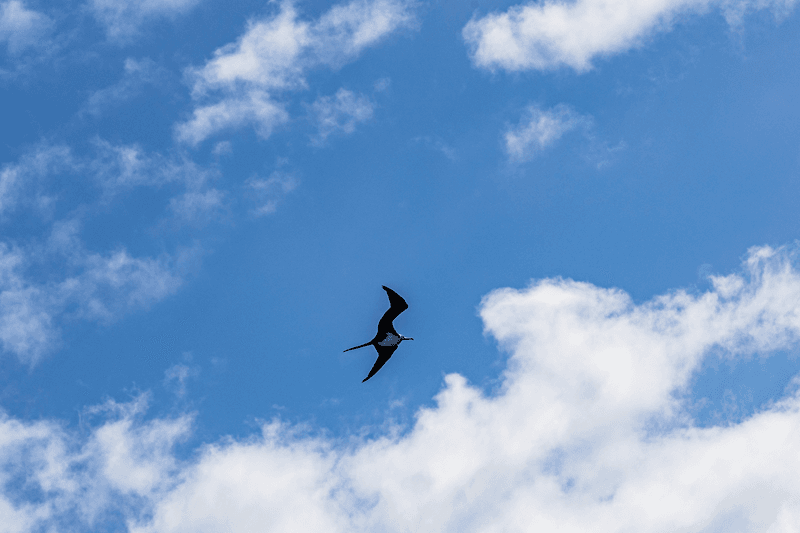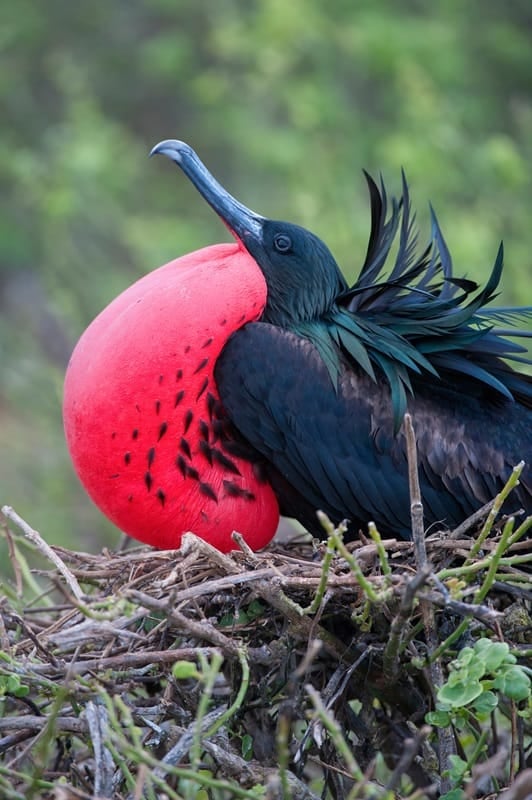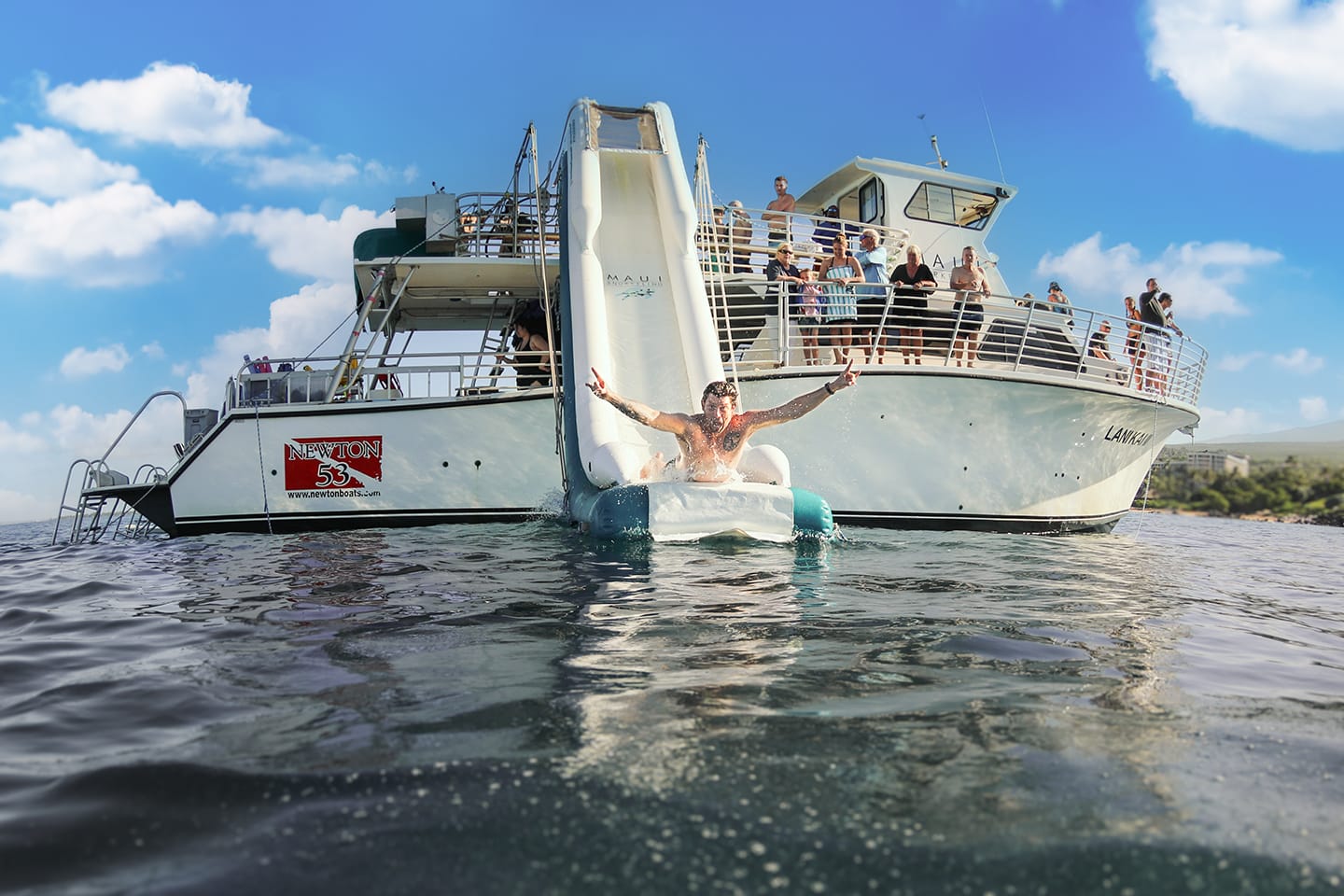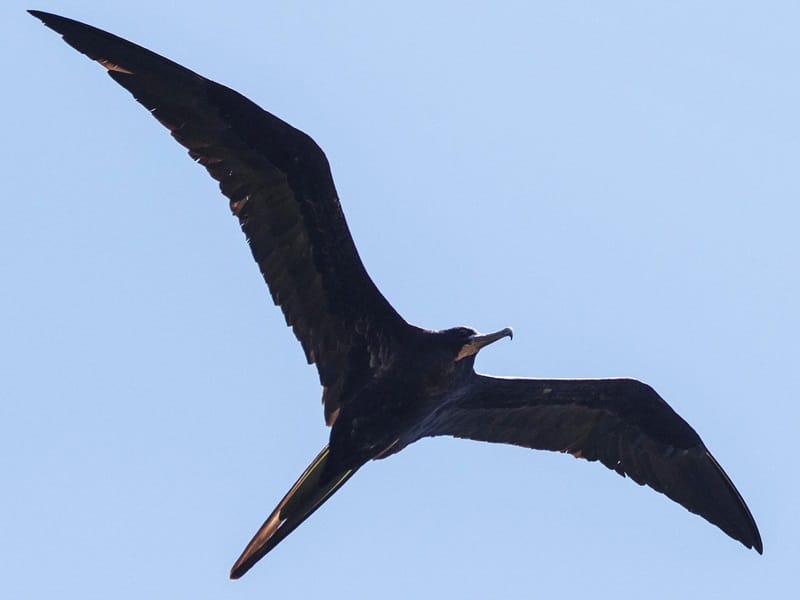¡Aloha! ¿Alguna vez has visto un pájaro con alas largas y puntiagudas que parece capaz de volar eternamente por el Océano Pacífico? ¿O quizás un pájaro con un globo rojo enorme y brillante bajo la barbilla? Pues prepárate para aprender sobre una de las aves más geniales de las islas hawaianas: el Gran fragata!
Si planeas una divertida excursión de snorkel con nosotros en Maui Snorkeling al asombroso cráter Molokini, quizás tengas suerte y veas una de estas increíbles aves surcando el cielo. ¡Son un espectáculo digno de contemplar!
Entonces, ¿qué es exactamente un? Gran fragata¡Vamos a sumergirnos y descubrirlo!
¿Qué diablos es una fragata?
Imagina un ave que es como un superhéroe del cielo. Las fragatas son aves marinas diseñadas para vivir en los océanos tropicales Pacífico e Índico, donde las aguas cálidas y la abundancia de alimento las convierten en el hogar perfecto. Son aves marinas, lo que significa que pasan la mayor parte de su vida cerca del océano. Son expertas en volar y pueden permanecer en el aire durante días, incluso semanas, ¡sin aterrizar! Casi nunca baten las alas, así que no se cansan fácilmente. Increíble, ¿verdad?
Hay varios tipos de fragatas, pero hablaremos específicamente de la fragata común. Es una de las más grandes e impresionantes de todas.
La fragata grande, también conocida como ave de guerra, es famosa por su agilidad aérea y sus extraordinarias tácticas de caza. A menudo se une a bandadas mixtas en el mar, a veces planeando sobre piqueros patirrojos y pardelas cuneiformes en busca de peces y calamares. Estas aves también son conocidas por su dimorfismo sexual: los machos y las hembras tienen un aspecto diferente: los machos lucen la icónica bolsa roja y las hembras presentan el pecho blanco y el plumaje oscuro.
La dieta de la fragata común se compone principalmente de peces y calamares que captura directamente del agua. A veces, incluso les hace una pequeña broma y roban comida a otras aves. Esta estrategia de alimentación oportunista, conocida como cleptoparasitismo, les permite prosperar en los ecosistemas marinos.
¿Y adivina qué? ¡Las fragatas grandes también son muy buenas para pasar tiempo con sus amigos! A menudo se las puede ver en grupos grandes, charlando y haciendo cosas de aves juntas, sobre todo cuando llega el momento de buscar pareja.
Las características clave incluyen:
• ¡Tienen una cola profundamente bifurcada y alas puntiagudas!
• Los machos pueden inflar una bolsa roja brillante debajo de su barbilla como un globo cuando quieren decir "¡Hola, estoy aquí!"
• Capacidad de permanecer en el aire durante mucho tiempo.
• Lamentablemente, cada vez es más difícil para ellos encontrar buenos hogares porque las cosas están cambiando en el entorno, por lo que debemos tener mucho cuidado.
La fragata grande es fundamental en su hábitat marino. Ayuda a mantener el equilibrio comiendo ciertos peces y relacionándose con otras aves marinas. Verlas es como comprobar la salud del océano: si están bien, ¡es buena señal! Así que, ¡hagamos nuestra parte para mantener sus hogares sanos y salvos!
Características físicas
Los rasgos físicos de la fragata común son llamativos y funcionales. Algunas características físicas clave incluyen:
• ¡Plumas negras súper brillantes! Sus plumas son mayoritariamente negras, pero no son simplemente negras: son elegantes y brillantes, ¡como si acabaran de ser pulidas!
• Ligero como una pluma (¡casi!) Estas aves son superligeras, lo cual explica por qué pueden volar tanto tiempo. Imagina intentar volar con una mochila llena de piedras: ¡sería difícil! Pero las fragatas son agradables y ligeras, lo que facilita mucho el vuelo.
• ¡Un anzuelo de pesca incorporado! Observa detenidamente su pico: ¡tiene un pequeño gancho al final! Este pico especial es perfecto para atrapar peces resbaladizos en el aire o desde la superficie del agua. ¡Es como tener una caña de pescar siempre pegada a la cara!
• ¡No soy tan bueno nadando! Aquí hay algo curioso: las fragatas no tienen mucho aceite en las plumas como los patos. Ese aceite les ayuda a mantenerse secos en el agua. Debido a su falta de aceite, las fragatas no flotan bien ni pasan mucho tiempo en el agua. Por eso son tan increíbles voladoras: ¡necesitan mantenerse en el aire!
La parte “grande” de la fragata gigante
Entonces, ¿qué hace a la Fragata Grande tan… genial? Bueno, para empezar, ¡son aves enormes! Sus alas pueden extenderse muchísimo, ¡a veces más de 2 metros! ¡Eso es incluso más ancho que la altura de algunos adultos! Estas largas alas les permiten planear sin esfuerzo por el aire.
Son mayormente de color negro, lo que les ayuda a absorber el sol y mantenerse calientes mientras vuelan sobre el océano. Pero lo más destacable del macho de Fragata Grande es algo que no te perderás si lo ves.
¡El globo rojo brillante!
El macho de la fragata común tiene un truco especial durante la época de apareamiento. Tiene una gran bolsa roja bajo la garganta que puede inflar como un globo. Esta bolsa roja brillante es como un gran cartel que dice: "¡Mírenme! ¡Soy un pájaro fuerte y guapo!".
Cuanto más grande y brillante sea la bolsa, más probable es que atraiga a una fragata hembra. ¡Es como un desfile de moda para pájaros!
¿Dónde viven estas increíbles aves?
Las fragatas grandes prefieren los lugares cálidos, por lo que se pueden encontrar en zonas tropicales y subtropicales de todo el mundo. ¿Y adivina qué? ¡Hawái es uno de esos lugares! Suelen frecuentar costas e islas donde abundan los peces.
Aquí es donde nuestro Excursión de snorkel en el cráter Molokini ¡Entra! El cráter Molokini es un lugar único. Es la cima de un antiguo volcán que ahora está bajo el agua, creando una hermosa forma de medialuna. Es un área protegida con abundante vida marina, lo que significa que hay muchos peces alrededor. Esto lo convierte en un lugar ideal para... Grandes fragatas Para pasar el rato y buscar comida.
Cráter Molokini Es un lugar popular para estas aves por algunas razones:
• Un montón de peces: Las aguas cristalinas que rodean el cráter están repletas de peces, principal fuente de alimento de las fragatas.
• Perchas altas: Los bordes del cráter ofrecen lugares elevados donde las aves pueden posarse y descansar. Es posible verlas sentadas en el borde del cráter, disfrutando del sol.
• Corrientes de aire: La forma en que el viento fluye alrededor del cráter puede crear corrientes ascendentes, como elevadores naturales para las fragatas. Pueden usar estas corrientes de aire para planear sin esfuerzo y sin batir mucho las alas.
Excursión matutina de snorkel en el cráter Molokini
• Funciona diariamente de 7 a. m. a 12 p. m.
• Incluye snorkeling en dos lugares increíbles: Cráter Molokini y Turtle Town.
• Disfrute deslizándose en el agua y nadando con peces tropicales y amigables tortugas marinas.
• Deliciosos desayunos y almuerzos incluidos.
• Se proporciona equipo de snorkel para todos, por lo que no tendrá que preocuparse por traer el suyo.
Mantén la vista puesta en el cielo cuando estés en nuestro barco rumbo al cráter Molokini o mientras buceas con snorkel. A menudo se les ve sobrevolando el océano y buscando alimento.
Observa el borde superior del cráter. Quizás los veas sentados allí, descansando o acicalándose las plumas. Estate atento a las aves marinas más pequeñas perseguidas por un mirlo más grande. ¡Podría ser una fragata intentando robar un bocadillo!
Nuestra amable tripulación suele ser experta en avistar fauna. Si no está seguro de haber visto una fragata, ¡pregúnteles! Pueden ayudarle a identificar diferentes aves y señalárselas. A veces, las verá de inmediato, y otras, tendrá que esperar un poco. ¡Siga mirando hacia arriba!
Comportamientos y adaptaciones
El comportamiento de la fragata común es una obra maestra de adaptación. Entre sus comportamientos y adaptaciones clave se incluyen:
• ¡Viajando en los ascensores invisibles! Las fragatas son voladoras inteligentes. Saben cómo aprovechar el aire cálido, llamado corriente térmica, para poder volar largas distancias sin cansarse demasiado. ¡Es como encontrar un ascensor invisible en el cielo que las eleva para poder planear kilómetros!
• ¡Interacciones sociales con grandes colonias! A estas aves les encanta ser sociables y viven en grandes grupos llamados colonias. ¡Imagina tener un vecindario lleno de tus mejores amigos pájaros! Charlan y hacen cosas juntas, especialmente a la hora de construir nidos y cuidar a sus crías.
• ¡Robo furtivo de bocadillos! Tienen una forma especial de conseguir alimento llamada cleptoparasitismo. Es una palabra compleja, pero simplemente significa que a veces persiguen a otras aves marinas hasta que sueltan su delicioso pescado, ¡y entonces la fragata se lanza en picado y lo atrapa! Puede sonar un poco atrevido, pero es una forma ingeniosa de conseguir comida.
• ¡Sin aterrizar durante días! ¿Te imaginas estar despierto y de pie durante días y días? Es parecido a lo que hacen las fragatas, ¡pero en el aire! Pueden volar durante largos periodos sin posarse en el agua ni en tierra. ¡Son auténticas campeonas del cielo!
¡Maestros del Cielo!
Ya hemos mencionado lo asombrosas que son estas aves al volar, ¡pero vale la pena repetirlo! Están hechas para la vida en el aire. Sus cuerpos son muy ligeros y sus largas alas les permiten planear en las corrientes de aire durante horas. ¡Incluso pueden volar tan alto que casi desaparecen entre las nubes!
Como son tan buenos volando y no tan buenos aterrizando en el agua (sus plumas no son impermeables), pasan la mayor parte del tiempo en el aire. ¡Incluso pueden dormir mientras vuelan! Imagina echarte una siesta mientras flotas en el cielo: ¡es genial!
El arte del cleptoparasitismo
¡Hablemos más sobre ese astuto robo de bocadillos! La fragata gigante puede ser un poco como un pirata. ¡El cleptoparasitismo es su truco pirata especial! Es como si se hubieran vuelto expertos en el arte de robarles bocadillos a otras aves. No solo piden con educación, sino que usan su inteligencia y sus habilidades de vuelo para conseguir lo que quieren.
Imagina que eres otra ave marina y acabas de pescar un delicioso pescado. Vas volando, listo para comértelo, ¡cuando de repente aparece una fragata negra enorme! Son muy buenas molestando a otras aves en el aire, como un matón juguetón (¡pero así es como consiguen comida!).
Podrían perseguirlos y batir sus enormes alas hasta que el otro pájaro se asuste o se canse tanto que deje caer el pez. ¿Y adivina quién está ahí para atraparlo? ¡La astuta y magnífica fragata!
Esta forma sigilosa de conseguir comida ayuda a las fragatas a ahorrar energía. En lugar de tener que zambullirse siempre en el agua para pescar (¡algo que no se les da muy bien!), pueden usar sus habilidades de vuelo para conseguir comida gratis. Es como encontrar un helado caído: ¡un regalo de la suerte!
Así que, aunque pueda parecer un poco travieso, este robo de bocadillos es fundamental para que la fragata gigante sobreviva en el océano. ¡Demuestra lo inteligentes y adaptables que son en su mundo acuático! Desempeñan una función especial en la cadena trófica del océano, ¡aunque implique algo de piratería juguetona!
Excursiones de snorkel en el cráter Molokini
¡Reserva ya tu excursión al cráter Molokini! Practica snorkel y nada en las aguas cristalinas de Maui. ¡Quizás incluso veas la fragata gigante!
Reproducción y ciclo de vida
Durante la época reproductiva, las fragatas comunes se reúnen en una bulliciosa colonia, a menudo junto a otras aves marinas. Aquí, los machos inflan su bolsa roja de la garganta, tamborileándola con el pico para atraer a su pareja. Ver docenas de estas bolsas infladas en un solo lugar es un verdadero espectáculo para la vida silvestre.
¡Echemos un vistazo a la vida familiar de la Fragata Grande! Tienen una forma emocionante de tener crías. No es que tengan polluelos cada año. ¡De hecho, suelen tener crías solo una vez cada dos años! Puede parecer mucho tiempo, pero quieren ser buenos padres para cada cría.
¿Y adivina qué? Las fragatas pueden vivir mucho tiempo, ¡a veces incluso más de 30 años! Eso significa que tienen muchas oportunidades de tener crías a lo largo de su vida, aunque se toman su tiempo entre cada una. A lo largo de sus largas vidas, también tienen maneras geniales de encontrar pareja. Es como un baile especial de pájaros y una especie de presumir para decir: "¡Oye, sería una madre estupenda!".
Construyendo una casa en el cielo (¡Casi!)
Las fragatas comunes suelen construir sus nidos en arbustos o árboles bajos en islas o cerca de la costa. Usan palos y ramitas para construir una plataforma. Tanto el macho como la hembra ayudan a construir el nido.
La hembra suele poner un solo huevo. Puede que no parezca mucho, pero significa que dedican mucho cuidado y atención a la crianza de su polluelo.
¡Pequeños bebés fragatas!
Cuando la cría de fragata nace, está cubierta de un suave plumón blanco. Ambos padres se turnan para alimentar y cuidar al polluelo. El polluelo crece lentamente y permanece en el nido durante mucho tiempo, ¡a veces hasta seis meses! Incluso después de dejar el nido, los padres pueden seguir alimentándolo durante varios meses más. ¡Eso requiere mucha dedicación!
Ayudando a nuestros amigos emplumados: ¡Desafíos y cómo podemos colaborar!
Uno de los grandes problemas es la pérdida de hábitat. Los lugares donde las fragatas anidan están siendo modificados o incluso desapareciendo. Además, la contaminación, como la basura marina, puede perjudicarlas y a los peces que consumen.
Otro problema complejo es el cambio climático. Este puede calentar el océano, lo que puede cambiar el lugar donde viven los peces y calamares. Si sus alimentos favoritos se desplazan, a las fragatas les resulta más difícil encontrar alimento.
Pero no se preocupen, ¡hay mucha gente intentando ayudar! Es importante proteger sus nidos. Esto significa garantizar que los lugares donde construyen sus nidos sean seguros y no se alteren. Piensen en ello como colocar un gran cartel de "Prohibido el paso" para mantener sus hogares seguros.
Se están creando santuarios marinos, que son áreas protegidas especiales en el océano. Aquí, las aves y otras criaturas marinas pueden vivir a salvo. Dado que estas aves viajan a diversos lugares, ¡personas de diferentes países se unen para protegerlas!
¡Tú también puedes ser un héroe de la vida silvestre! El papel de los viajes divertidos y el aprendizaje.
¿Adivina qué? ¡Incluso una divertida excursión de snorkel puede ayudar a las fragatas! Ahí es donde entra el ecoturismo. Descubrimos lo asombrosas que son estas aves cuando participamos en tours que nos enseñan sobre la naturaleza, como los de Maui Snorkeling. También aprendemos por qué es importante protegerlas. ¡Es como ir en busca del conocimiento!
Podrás avistar aves increíbles en nuestros tours de snorkel al cráter Molokini. ¡Nuestro equipo está listo para compartir curiosidades sobre ellas! Aprenderás cómo encajan en el panorama general del océano y cómo todo está conectado. Esto nos ayuda a todos a cuidar más sus hogares.
Creemos en el turismo sostenible. Esto significa que hacemos cosas que protegen el medio ambiente y a los animales. Así que, al visitarnos, nos ayudas a demostrar que podemos divertirnos y, al mismo tiempo, ser buenos amigos de la vida silvestre. Al aprender y vivir experiencias increíbles, ¡formas parte del equipo que ayuda a salvar a la Fragata Grande! ¡Únete a nosotros, aprende sobre estas fantásticas aves y conviértete en un héroe de la naturaleza!
¡Recuerde ser respetuoso!
Es emocionante ver estas increíbles aves, pero es importante respetar su espacio. Debemos observarlas a distancia y nunca intentar alimentarlas ni molestarlas. Queremos asegurarnos de que sigan prosperando en su hábitat natural.
Foto cortesía de eBird
La gran fragata: ¡una verdadera maravilla del cielo!
El Gran fragata Es un ave verdaderamente extraordinaria. Su increíble habilidad para volar, su singular bolsa roja y sus curiosos hábitos la convierten en una criatura fascinante de observar. Esperamos que en su próxima aventura de snorkel con Maui Snorkeling al cráter Molokini, tenga la oportunidad de presenciar la majestuosidad de estos maestros del aire. ¡Mantenga los ojos bien abiertos y quizás tenga la suerte de ver una fragata grande sobrevolando las hermosas aguas azules de la isla de Maui!
¡Estamos deseando tenerte a bordo! ¡Prepárate para explorar las impresionantes vistas del cráter Molokini, tanto sobre el agua como bajo ella! Reserva tu tour hoy ¡Prepárate para una aventura inolvidable! ¡Quizás veas una de estas increíbles fragatas!
Mira otra ave de Maui: Pájaro piquero!




